Speckle reduction in imaging applications and an optical system thereof
a technology of optical system and imaging application, applied in the field of optical devices, can solve the problems of reducing the quality of displayed images, causing unwanted artificial effects of solid-state light sources,
- Summary
- Abstract
- Description
- Claims
- Application Information
AI Technical Summary
Benefits of technology
Problems solved by technology
Method used
Image
Examples
Embodiment Construction
[0025]Disclosed herein is a method of reducing speckle effect in display applications that employ phase-coherent light by using a frequency comb generated from the phase-coherent light. The phase-coherent light in the frequency comb causes separate speckle patterns on the screen. The separate speckle patterns overlap on the screen and average out as a noise background. Also disclosed is an optical structure capable of generating a frequency comb that comprises substantially discrete light lines of different frequencies by using a non-linear optical fiber. As will be detailed afterward, the optical structure can be used independently of the method of speckle reduction.
[0026]The speckle reduction method and the optical structure capable of reducing speckle effect will be discussed in the following, with particular examples where speckle patterns from speckle effect are caused by lasers. However, it will be appreciated by those skilled in the art that the following discussion is for de...
PUM
 Login to View More
Login to View More Abstract
Description
Claims
Application Information
 Login to View More
Login to View More - R&D
- Intellectual Property
- Life Sciences
- Materials
- Tech Scout
- Unparalleled Data Quality
- Higher Quality Content
- 60% Fewer Hallucinations
Browse by: Latest US Patents, China's latest patents, Technical Efficacy Thesaurus, Application Domain, Technology Topic, Popular Technical Reports.
© 2025 PatSnap. All rights reserved.Legal|Privacy policy|Modern Slavery Act Transparency Statement|Sitemap|About US| Contact US: help@patsnap.com



